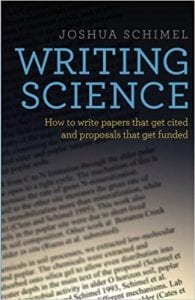(by Dr Charlotte Lloyd, Postdoctoral Research Associate, School of Chemistry)
If you are looking for an easy to read guide to science writing, then this could be the book you have been waiting for. I have started reading many a book about how to improve your scientific writing, how to design robust science experiments etc etc, however usually I only manage to wade through the first couple of chapters before I give up and decide I shouldn’t waste any more precious time and just get on with the work in question! This book however was different. It was incredibly easy to read, and I comfortably made it through the 206 pages in a few sittings (actually, the times while my baby was napping during a week’s canal boating holiday!). While I think this book is useful and the advice would hold for writing across different disciplines, I think it is extremely useful for anyone who is involved in science research, particularly the environmental sciences. The author provides numerous examples in each section to really bring the advice to life and uses extracts from actual science writing, whether it be journal papers or grant proposals, explaining why the text does a good or bad job, and importantly in the case of the latter, how the piece could be improved. This technique for teaching I found extremely useful and allowed me to reflect on my own and colleagues writing and as a result enabled me to rapidly provide constructive suggestions to improve text I have been involved with writing.
The book has a logical structure (perhaps the very least you might expect given the subject matter of the book!!), beginning with the fundamentals of how to tell your story and what makes a story compelling, before focusing in on individual aspects of the writing itself. The author covers the designing of the structure of a piece, how to plan paragraphs and even how to think about each individual sentence and making sure each and every line of text plays an integral role – this is invaluable when writing something like a grant proposal where tight space restrictions often apply. The chapters of the book are to a certain extent self-contained, so it is very easy to dip in and out of the book to gain advice about a specific aspect of writing you may be struggling with. For anybody who finds writing a challenge or feels daunted by the prospect of editing and refining their work, I would highly recommend reading this book. It has made writing a much more enjoyable experience for me, and this is fundamental because as the author points out, as research scientists we are in fact professional writers!


